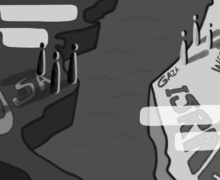The Connective Corridor is working on promoting its utility around the city. It’s even taken out the word ‘use’ from Syracuse to prove its point.
The ‘use’ campaign is coming to fruition with the help of three Syracuse University industrial design majors. The students will work on recreating the exterior and interior of three Connective Corridor buses that link the campus to the city. The buses are set to debut later this month.
Fifth-year industrial design students Cat King, Heidi Hakala Olean and Ana Mihai started to work on the project last fall. The students met with the director of the Connective Corridor project, Robbi Farschman, throughout last semester to plan the designs. Each student was responsible for producing her own original design for each bus, and they have since been actively involved in the process of perfecting the buses.
The purpose of this new identity is to help brand the corridor in terms of color, font and the new ‘use’ identity marketed specifically for the Corridor, he said.
‘We’re looking at Syracuse and pulling out the ‘use’ at the end of (the word) and thinking about ‘What can I use?” Farschman said. ‘Use the bus, use your feet, use your imagination, just being really creative with how we think of the word ‘use,’ and the bus will be a part of starting that creativity.’
The original bus wraps were made in 2007 and were also designed by students in the industrial design program at SU. Each wrap, large sheets of vinyl-like material with an industrial-strength adhesive, lasts for about five years.
In 2009, a demand for bigger buses due to an increasing number of passengers presented an opportunity to promote a new image for the Connective Corridor, Farschman said.
The need to more precisely brand the Connective Corridor stems from general misinterpretations and misinformed ideas of what the Connective Corridor is. The line has essentially become synonymous with buses, as many people believe it’s simply a bus route, she said. Farschman said this is a common misconception she is trying to prevent.
‘The corridor is a movement to help elevate the arts and cultural opportunities and institutions we have in the community,’ Farschman said. ‘The bus is one of the ways that we can connect to these cultural venues, and I think this year people are going to begin to understand the corridor differently in the course of this year.’
Working closely with Farschman and in conjunction with Centro and Pentagram, a branding company based in New York City, students King, Olean and Mihai have created three different designs for three buses that reflect the Corridor’s new identity.
‘When something is blown up compared to when you’re looking at your little computer, it’s very different,’ King said. ‘Little things that you didn’t notice before are pronounced, so we’d go through each, very detail oriented and picking out things that we saw.’
The three buses each have their own distinctive theme that sticks to the ‘use’ mentality. One bus has a museum theme, another has a wave or water theme and the last features colorful dots. According to February’s Connective Corridor newsletter, the buses share common features as well: the same typeface, the same colors and the ‘use’ identity.
The buses will also include original designs for the interior of each bus that complements the theme of the exterior. Alexandra Fiust and Benjamin Lin, both interior design students, redesigned the three buses’ interior in 2009.
Interior design assistant professor Jennifer Hamilton guided them through the design process and helped implement the students’ designs for the actual buses. This will be the first time the buses will have unique designs for the interior.
‘This time around, we looked at their interior designs and tried to think of ways that we could join the two,’ said Olean, who also worked on the design for the original bus wrap designs in 2007.
The buses were originally set to be revealed Jan. 18, but production has been facing delays with the assembly of the interior, primarily the installation of the fabrics chosen specifically for each bus’ designs, Farschman said.
Colin Cavanaugh, a sophomore industrial and interactive design major, said he’s excited about the possibility of working on a project like this in the future. Cavanaugh, who takes four classes at The Warehouse downtown and works in the woodshop there, rides the Connective Corridor bus Monday through Friday. He was impressed by the opportunity presented to his peers and said it’s a great way for students pursuing a career in industrial design to gain experience.
‘It’s a different field than I want to go into, but that sounds like a great experience in general for any student in that field to have,’ Cavanaugh said. ‘I can’t wait to see what they did with them. I’m sure they must be pretty awesome.’
The industrial design students said getting involved in the out-of-class project, which counts as experience credit, was not difficult. All three said that despite the large amount of work and time that goes into the project, they do not regret it and even like that their work is for a real client.
‘This project is produced and out there, as opposed to doing this other project for class that will sit on my desk,’ Olean said. ‘Everybody will see this.’
Published on February 9, 2011 at 12:00 pm
Contact Danielle: dmodiama@syr.edu | @daniemarieodie


